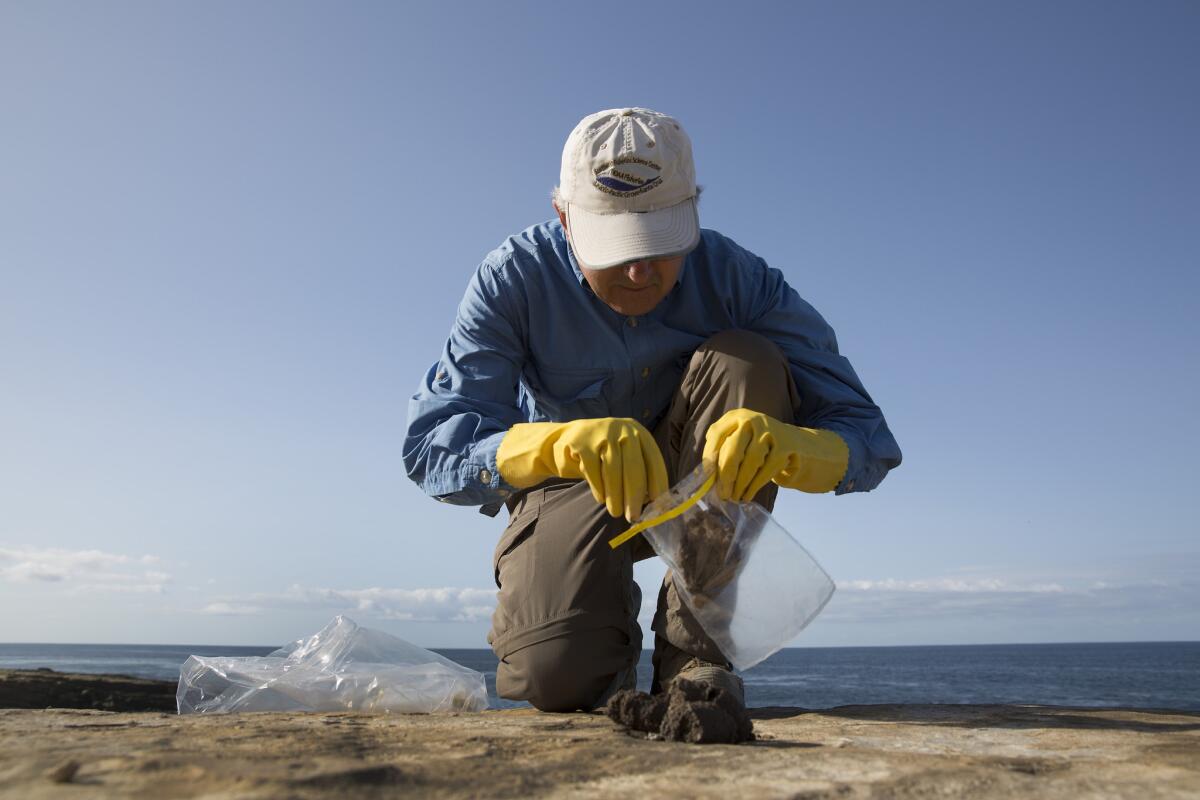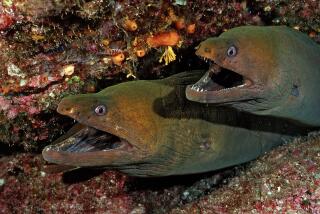Scat may contain clues to marine mammals’ Southern California deaths

Biologist Mark Lowry collects sea lion and elephant seal scat.
SAN NICOLAS ISLAND, Calif. — Mark Lowry has collected sea lion and elephant seal scat from San Nicolas and San Clemente islands for more than three decades to track the long-term health of marine mammal life off the California coast.
But the federal biologist’s work has new meaning — and urgency — this year. Analyses of the specimens could solve the mystery of why so many young sea lions have been found dead and dying on Southern California beaches.
Keeping a wary eye on a herd of elephant seals lolling on rocks perched over the pounding surf here on a recent weekday, Lowry put on rubber gloves and used a dinner spoon to scoop up piles of seal scat and plop them into plastic specimen bags.
Lowry, a National Oceanic and Atmospheric Administration biologist, hoped the pungent material contained answers to why at least 2,250 dehydrated and underweight sea lions started showing up on local beaches in January — around the time he detected evidence of an unprecedented shift in the species’ eating habits.
Specifically, Lowry found what he described as “mystery stuff — gooey bits of substance you’d expect from a diet of jellyfish or tube worms.”
Sea lions are opportunistic predators that typically feed on mackerel, sardines, rockfish and market squid. But amid El Niño-like conditions and a dearth of fish and squid to prey on, they may be trying to sustain themselves on novel food sources, he said.
“These findings are preliminary,” Lowry said. “But it could mean sea lions are starving and eating what little they can find to fill their stomachs up.”
There were 350 ailing sea lion pups stranded on local beaches in January, 850 in February and 1,050 in March, according to the latest numbers released by the National Marine Fisheries Service.
The overall health of the California sea lion population, however, remains robust.
“The sea lion population is increasing at a rate of about 5.1% per year,” said Lowry, who also conducts annual aerial surveys of California’s pinniped populations. “In 1964, the sea lion population was about 30,000. Today, it is a tad over 300,000.”
Most of those sea lions breed on the wind-raked beaches of 3-mile-by-9-mile San Nicolas Island, the outermost of the eight Channel Islands and pinniped capital of the United States.
San Nicolas is populated by about 200 military and civilian residents. But for several months beginning in December and continuing into spring, it is breeding grounds for tens of thousands of California sea lions, elephant seals and harbor seals.
Lugging his collecting gear and buckets down a sandstone bluff toward raucous herds of sea lions and elephant seals weighing as much as 3,000 pounds, Lowry, 64, said with a laugh, “This is field biology at its finest.”
Moments later, he was in his element, on his knees and harvesting seal scat on this desert isle used by the Navy to test the latest missile defense systems.
“If flies are interested in it, I’m interested,” he said. “No joke.”
He aimed to collect 15 pounds of the stuff for analysis later in his La Jolla laboratory. That process involves soaking the samples in buckets of fragrant soapy water, then pouring them through wire-mesh seines to separate out bony particles that can determine the species, size and age of the fish and squid eaten.
“The value of Mark’s data is enormous,” said Doug Demaster, science and research director of NOAA’s Alaska region fisheries. “Shifts in the diets of sea lions are among the earliest signals we get of impending El Niño events, which mean wholesale shifts of wind and storm patterns, and changes in the marine ecology.
“Beyond that, we all want to know why the number of dying sea lion pups on California’s beaches has jumped from a few dozen a year to thousands in the past three months alone.”
Seals have altered their feeding habits several times over the last three decades, Lowry said. In the 1980s, for example, they were eating mostly anchovies and sardines. In the 1990s, they started going after squid. During El Niño events, they chase rockfish.
“The mystery stuff I’m finding now is altogether new,” he said. “I intend to figure out exactly what it is.”
Lugging a 5-gallon bucket full of scat samples back to his pickup after a productive day of prospecting, Lowry smiled and said, “I have no plans to retire, and my bosses are very happy about that.”







